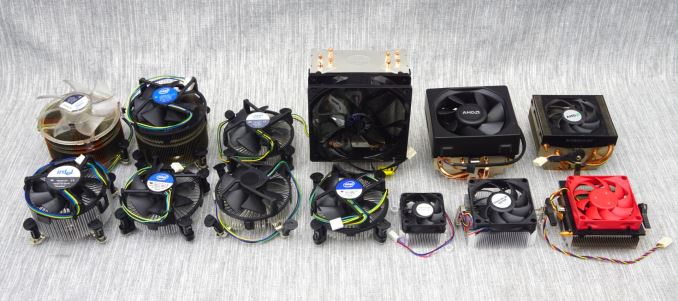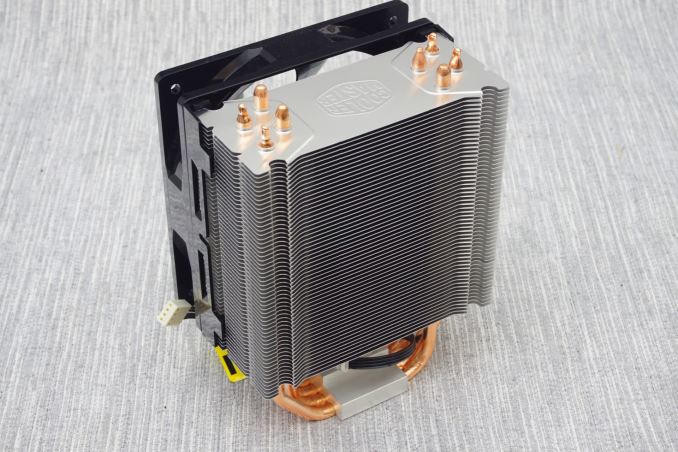Battle of The CPU Stock Coolers! 7x Intel vs 5x AMD, plus an EVO 212
by E. Fylladitakis on July 22, 2016 9:00 AM EST- Posted in
- Cases/Cooling/PSUs
- CPUs
- AMD
- Intel
- Cooler Master
- Cooler

Advanced PC users that like to care for their system commonly believe stock cooling solutions that are supplied with processors to be either barely adequate or too noisy even for a standard, unmodified system operating at stock frequencies. With bulk PC orders it is, of course, a difference scenario when every penny counts. But as a result of the perception of poor cooling from these 'default' coolers, most enthusiast users seek aftermarket cooling solutions. This has created a vast and multivariate demand, and there are so many companies offering such a wide variety of cooling products, from $20 all the way up to custom water cooling solutions. But is that really necessary for a mid-range build? We gathered together around a dozen stock coolers from across the years, from AMD and Intel, and pitted them against the highly rated EVO 212 from Cooler Master.
Introduction
Modern CPUs have become more efficient over time, and have begun to have lower cooling requirements. As a result, the CPU manufacturers have designed some rather advanced stock coolers and are either supplying them alongside their top-tier CPUs or selling them as aftermarket solutions. Despite the fact that these are the 'certified' coolers for the processors, the CPU manufacturer has to make millions, to every hundredth of a cent in manufacturing can be important to the bottom line. It is not easy for the average user to assess just how good the stock cooler really is and how much of an improvement, if any at all, there will be from the purchase of an aftermarket cooler. End users need to be aware of the performance of their current cooling solutions in order to reasonably assess the upgrade that will fit their needs.
In this review we will showcase the thermal performance of some popular stock CPU coolers of the last few years, including the controversial aftermarket Intel BXTS15A and the highly touted AMD Wraith. We also included one of the most popular mainstream coolers available, the Cooler Master EVO 212, as a baseline comparison against aftermarket solutions.
The coolers that we will be testing are in the following table, along with core/fin material listed, the size of the fan, and the overall mass of the cooler as measured on our units. Where heatpipes are in play, these are added into the Core section.
| Vendor | Cooler | Common Bundle | Core | Fins | Fan (mm) |
Mass (g) |
| Intel | D75716-002 | Socket 775 Celerons | Alu | Alu | 80 | 118 |
| C25704-002 | Socket 775 P4 6x0 | Cu | Alu | 80 | 132 | |
| E97378-001 | Socket 1155 Intel i5 | Cu | Alu | 80 | 146 | |
| E97379-001 | Socket 1155 Intel i3 | Alu | Alu | 80 | 92 | |
| D60188-001 | Socket 775, C2D E8x00 | Cu | Alu | 80 | 419 | |
| E31964-001 | Socket 1366 i7-X | Cu | Cu/Alu | 100 | 435 | |
| BXTS15A | Aftermarket, ≈$30 | Cu | Alu | 80 | 362 | |
| AMD | 1A213LQ00 | AMD “Kabini” AM1 | Alu | Alu | 50 | 75 |
| FHSA7015B | Several AMD Lines | Alu | Alu | 70 | 164 | |
| AV-Z7UB408003 | Black Edition Phenom | Alu +2 Cu HP |
Alu | 70 | 374 | |
| Wraith (125W) | AMD FX-8370 AMD A10-7890K |
Cu +4 Cu HP |
Alu | 90 | 304 | |
| Cooler Master | HK8-00005 | AMD FM2+ “Godavari” CPUs | Alu | Alu | 70 | 125 |
| EVO 212 | Aftermarket, ≈$30 | Cu +4 Cu HP |
Alu | 120 | 436 |











82 Comments
View All Comments
yannigr2 - Friday, July 22, 2016 - link
Your comment makes you look stupidly indeed. A company is giving a top quality cooler that saves you $20-$30 and you find it stupidly sad?SetiroN - Friday, July 22, 2016 - link
Yes, I find the fact that the best thing a CPU manufacturer's got going is their bundled cooler extremely sad.yannigr2 - Saturday, July 23, 2016 - link
Some people will find sadness in everything AMD does. At the same time they will praise Nvidia or Intel for doing the exact same thing.DanNeely - Friday, July 22, 2016 - link
I disagree. While part of this demonstrates clearly what most of us already know; most stock coolers suck. It also shows that AMD actually did deliver a good stock cooler in the Wraith. Cooling wise it matches the budget standby Cooler Master 212; and comes close to matching it in terms of sound as well making it the first stock cooler I wouldn't automatically recommend trashing for an aftermarket job.If I were nit picking, I'd've liked to've seen an affordable non-tower aftermarket cooler in the mix as well because slim profile cases don't have room for big towers. OTOH by including a 212 in the mix this article can be used as a baseline to compare testing results on them elsewhere.
A5 - Friday, July 22, 2016 - link
Meh. If AT is going to get back in the CPU cooler review game, this is a good place to start for two reasons.1) Make sure they're starting from a good assumption (stock coolers suck).
2) Compare it to the current most popular replacement.
From there, you can start adding in higher-end coolers and comparing them to the baseline.
Ratman6161 - Friday, July 22, 2016 - link
I don't necessarily agree that "stock coolers suck". They suck for most of the people who would be reading this article in the first place :) but are generally more than adequate for people running their system at stock speeds and more or less typical conditions.I think Intel has essentially taken the right approach. Bundle a good enough cooler with most CPU's since they are adequate to the task and the people using them won't know the difference anyway. Sell the "K" CPU's without a cooler. If you are buying a K, then then you are probably also a person who wants to chose their own cooling solution too. Everybody wins.
JoeyJoJo123 - Friday, July 22, 2016 - link
Except in the latter case you're actually losing.They USED to bundle the stock cooler, and even if it wasn't used permanently, it was certainly useful for testing boot or as something to hold you over until you save another ~$100 for an all-in-one CLC that couldn't fit your initial PC budget.
I'd be all in if the lack of the stock cooler also meant they dropped prices on those same kinds of CPUs, but the prices actually went up AND they lost the stock cooler. Double loss for the consumer.
mikato - Thursday, July 28, 2016 - link
I bought non-K Intel CPUs (and AMD CPUs) and aftermarket coolers. Up to this point, I had useless stock coolers that NEVER got used since most of the time I bought a decent aftermarket cooler at the same time I build the computer. There is no point selling them on ebay. They were just an unfortunate waste of resources.So now I appreciate both strategies. Either don't include a cooler (and its price), or include a decent budget cooler (for less added price than a low-end aftermarket cooler). Both work for me. But as you say, if Intel hasn't passed on that cost saving then that isn't good.
It would be interesting to know how many people that build their own computers also use a non-stock CPU cooler (excluding the higher end Intel and AMD's Wraith). And how has that evolved over time since CPUs produce less heat now, and since budget coolers have improved quite a bit for their price.
To me water cooling is just plain unnecessary and has been for a long time. Air cooling does easily well enough, for less money, and less hassle. You don't get much for spending the extra money.
JonnyDough - Monday, August 1, 2016 - link
Best comment. I have about 18 desktop PCs, all of them from the last 6 years or so. Only one has a stock cooler and that's my HTPC, because it's so watt that it's quiet with the stock and sits in my living room far from me. I also think water cooling is a waste, when all one needs is a good cooler and some case fans. Water cooling nets just a few degrees difference in ambient case. If your VRMs are getting hot because the mobo maker didn't put a heatsink on it, just throw some cheap heatsinks on it.dishayu - Friday, July 22, 2016 - link
It IS useful. It helps put definite numbers to the theory that we already know to be true (that stock coolers suck). It tells users how much of a benefit they would get, going from their stock cooler to a 212 Evo (and subsequently other coolers they test in the future).This is good work, show some respect.